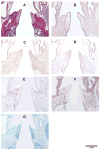A bovine acellular scaffold for vocal fold reconstruction in a rat model
- PMID: 19165789
- PMCID: PMC2787909
- DOI: 10.1002/jbm.a.32279
A bovine acellular scaffold for vocal fold reconstruction in a rat model
Abstract
With a rat model of vocal fold injury, this study examined the in vivo host response to an acellular xenogeneic scaffold derived from the bovine vocal fold lamina propria, and the potential of the scaffold for constructive tissue remodeling. Bilateral wounds were created in the posterior vocal folds of 20 rats, and bovine acellular scaffolds were implanted into the wounds unilaterally, with the contralateral vocal folds as control. The rats were humanely sacrificed after 3 days, 7 days, 1 month, and 3 months, and the coronal sections of their larynges were examined histologically. Expressions of key matrix proteins including collagen I, collagen III, elastin, fibronectin, hyaluronic acid, and glycosaminoglycans (GAGs) were quantified with digital image analysis. Significant infiltration of host inflammatory cells and host fibroblasts in the scaffold implant was observed in the acute stage of wound repair (3 days and 7 days postsurgery). The mean relative densities of collagen I, collagen III, and GAGs in the implanted vocal folds were significantly higher than those in the control after 3 days, followed by gradual decreases over 3 months. Histological results showed that the scaffolds were apparently degraded by 3 months, with no fibrotic tissue formation or calcification. These preliminary findings suggested that the bovine acellular scaffold could be a potential xenograft for vocal fold regeneration.
Figures









Similar articles
-
Controlled release of hepatocyte growth factor from a bovine acellular scaffold for vocal fold reconstruction.J Biomed Mater Res A. 2010 Jun 15;93(4):1335-47. doi: 10.1002/jbm.a.32632. J Biomed Mater Res A. 2010. PMID: 19876951 Free PMC article.
-
A biodegradable, acellular xenogeneic scaffold for regeneration of the vocal fold lamina propria.Tissue Eng. 2007 Mar;13(3):551-66. doi: 10.1089/ten.2006.0169. Tissue Eng. 2007. PMID: 17518602
-
Histological study of acute vocal fold injury in a rat model.Ann Otol Rhinol Laryngol. 2006 Apr;115(4):285-92. doi: 10.1177/000348940611500406. Ann Otol Rhinol Laryngol. 2006. PMID: 16676825
-
Retention of Human-Induced Pluripotent Stem Cells (hiPS) With Injectable HA Hydrogels for Vocal Fold Engineering.Ann Otol Rhinol Laryngol. 2017 Apr;126(4):304-314. doi: 10.1177/0003489417691296. Epub 2017 Feb 12. Ann Otol Rhinol Laryngol. 2017. PMID: 28290232
-
Tissue engineering-based therapeutic strategies for vocal fold repair and regeneration.Biomaterials. 2016 Nov;108:91-110. doi: 10.1016/j.biomaterials.2016.08.054. Epub 2016 Sep 2. Biomaterials. 2016. PMID: 27619243 Free PMC article. Review.
Cited by
-
An investigation of left-right vocal fold symmetry in rheological and histological properties.Laryngoscope. 2018 Oct;128(10):E359-E364. doi: 10.1002/lary.27271. Epub 2018 Aug 10. Laryngoscope. 2018. PMID: 30098041 Free PMC article.
-
Microstructure characterization of a decellularized vocal fold scaffold for laryngeal tissue engineering.Laryngoscope. 2014 Aug;124(8):E326-31. doi: 10.1002/lary.24605. Epub 2014 Mar 1. Laryngoscope. 2014. PMID: 24448829 Free PMC article.
-
The human umbilical vein with Wharton's jelly as an allogeneic, acellular construct for vocal fold restoration.Tissue Eng Part A. 2009 Nov;15(11):3537-46. doi: 10.1089/ten.TEA.2009.0064. Tissue Eng Part A. 2009. PMID: 19456236 Free PMC article.
-
Controlled release of hepatocyte growth factor from a bovine acellular scaffold for vocal fold reconstruction.J Biomed Mater Res A. 2010 Jun 15;93(4):1335-47. doi: 10.1002/jbm.a.32632. J Biomed Mater Res A. 2010. PMID: 19876951 Free PMC article.
-
Characterization of vocal fold scar formation, prophylaxis, and treatment using animal models.Curr Opin Otolaryngol Head Neck Surg. 2010 Dec;18(6):481-6. doi: 10.1097/MOO.0b013e3283407d87. Curr Opin Otolaryngol Head Neck Surg. 2010. PMID: 20962643 Free PMC article. Review.
References
-
- Ramig LO, Verdolini K. Treatment efficacy: voice disorders. J Speech Lang Hear Res. 1998;41:S101–116. - PubMed
-
- Hirano S. Current treatment of vocal fold scarring. Curr Opin Otolaryngol Head Neck Surg. 2005;13:143–147. - PubMed
-
- Gray SD, Titze IR, Chan RW, Hammond TH. Vocal fold proteoglycans and their influence on biomechanics. Laryngoscope. 1999;109:845–854. - PubMed
-
- Gray SD, Titze IR, Alipour F, Hammond TH. Biomechanical and histologic observations of vocal fold fibrous proteins. Ann Otol Rhinol Laryngol. 2000;109:77–85. - PubMed
-
- Sato K, Hirano M, Nakashima T. Stellate cells in the human vocal fold. Ann Otol Rhinol Laryngol. 2001;110:319–325. - PubMed
Publication types
MeSH terms
Substances
Grants and funding
LinkOut - more resources
Full Text Sources

